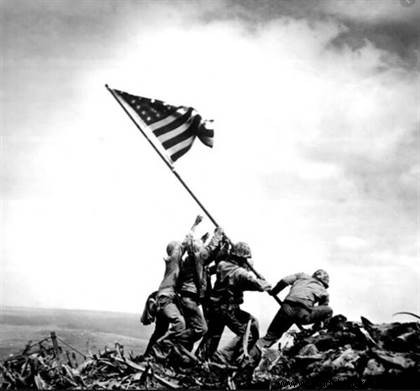 The War of the Pacific begins on December 7, 1941 with the surprise attack on Pearl Harbor and opposes the Empire of Japan and the United States (and their allies) for almost four years. It begins with a series of victories for the Japanese who impose themselves everywhere in Southeast Asia to the islands of the central Pacific. It was only after the battles of the Coral Sea and Midway that the Americans managed to turn the situation around. Bypassing the islands most fortified by the Japanese and often at the cost of heavy human losses, the allies progressed from the south until the Japanese archipelago was within range of American bombers. The Pacific War ends after the bombings of Hiroshima and Nagasaki, which precipitate the surrender of Japan, September 2, 1945.
The War of the Pacific begins on December 7, 1941 with the surprise attack on Pearl Harbor and opposes the Empire of Japan and the United States (and their allies) for almost four years. It begins with a series of victories for the Japanese who impose themselves everywhere in Southeast Asia to the islands of the central Pacific. It was only after the battles of the Coral Sea and Midway that the Americans managed to turn the situation around. Bypassing the islands most fortified by the Japanese and often at the cost of heavy human losses, the allies progressed from the south until the Japanese archipelago was within range of American bombers. The Pacific War ends after the bombings of Hiroshima and Nagasaki, which precipitate the surrender of Japan, September 2, 1945.
A Global Vision of the Pacific War
When we talk about the Second World War, in Europe and more particularly in France, the theater of the War of Pacific is often little known or even ignored. One could explain it by the fact that this war more specifically concerned the Japanese and the Americans, but that would also be to forget the presence of the European colonies, directly affected by the conflict, as well as the active English participation obviously, but also French, of these same Europeans.
Moreover, it is a pity to ignore a conflict of such magnitude, such impact, with such consequences, a real "world war in world war ! Let us rather judge:millions of fighters, in a theater of operations stretching from Burma to the Hawaiian Islands and from the Aleutians to Australia; titanic battles that have caused real revolutions in the art of war (in particular naval aviation); appalling dramas (Nanking, mass suicides and suicide bombers, and of course the atomic bombs),…
We will therefore try here to give a global vision of this war in the Pacific, by evoking the great movements, the turning points and the key points. Thus, we will not be able to go into the details of such and such a great battle, or debate on controversial subjects (Japanese crimes, "Did Roosevelt know about Pearl Harbor?", or even the relevance of the use of Bombs) but we will probably have the opportunity to come back to it…
Japanese imperialism
We usually start The Pacific War with Pearl Harbor; yet this conflict began long before the incredible all-out offensive of December 7-8, 1941.
We must emphasize the importance and power of Japan in this region since its victory in 1905 against Russia. A power that allows it to have claims, as evidenced by the sending of Japanese troops to Manchuria in 1919 and the virtual annexation of Korea. On the winning side in 1918, Japan was awarded, following the Treaty of Versailles in 1919, certain German possessions in the Pacific such as the Mariana, Caroline and Marshall Islands. A fascination with the European fascist regimes of the 1920s and 1930s begins to win over young Japanese officers, coupled with a resentment towards Europeans who have carved out empires in an Asia that Japan increasingly sees as its backyard. The army wields growing power in the country, and it is no coincidence that a major program for a war fleet has been launched, a sign of an ever-growing desire for power. This is indeed the birth of Japanese imperialism.
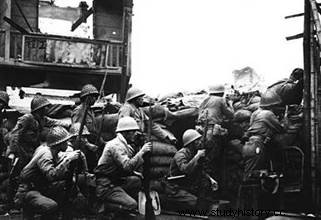 The stark evidence comes in the Manchuria Affair in 1931, where a grim case of road sabotage from iron serves as a pretext for Japan to seize the region, renamed Manchukuo. The League of Nations protested in vain, but Japan turned a deaf ear and even left the institution in 1933. This was only the first stage of the war against China , which resumed in 1937. The first phase was marked by the terrible Nanjing massacre (250,000 civilians killed, not counting the rapes and mutilations) and ended in 1939, after the conquest of northern China and most of from the coast to Canton. Japan is halted and faced with unexpected resistance, as well as the alliance between yesterday's enemies, Mao and Chiang Kai-Shek. At the same time, he must face the awakening of Russia, now Soviet, and which is wary of Japanese imperialism on this side of its gigantic territory. The Red Army inflicted two defeats on Japan in 1938 and 1939, and the Japanese government had to negotiate its neutrality, effective in April 1941.
The stark evidence comes in the Manchuria Affair in 1931, where a grim case of road sabotage from iron serves as a pretext for Japan to seize the region, renamed Manchukuo. The League of Nations protested in vain, but Japan turned a deaf ear and even left the institution in 1933. This was only the first stage of the war against China , which resumed in 1937. The first phase was marked by the terrible Nanjing massacre (250,000 civilians killed, not counting the rapes and mutilations) and ended in 1939, after the conquest of northern China and most of from the coast to Canton. Japan is halted and faced with unexpected resistance, as well as the alliance between yesterday's enemies, Mao and Chiang Kai-Shek. At the same time, he must face the awakening of Russia, now Soviet, and which is wary of Japanese imperialism on this side of its gigantic territory. The Red Army inflicted two defeats on Japan in 1938 and 1939, and the Japanese government had to negotiate its neutrality, effective in April 1941.
The Japanese agitation does not seem to make Westerners react:the Americans are still in their isolationist doctrine , even if from 1940 and the signing of the Tripartite Pact (Germany, Italy, Japan) in September, they began to worry seriously; and France and England are far too busy with Hitler's actions in Europe...
Climbing and the “day of infamy”
The signing of the Tripartite Pact confirmed the Japanese desire for escalation, but Westerners are still having trouble reading their intentions, and especially reacting when the war started in Europe and France was defeated in June 1940.
The conflict first resumes with China, but at the same time, Japan negotiates with certain countries in the region such as independent Thailand (Siam), playing on anti- -colonial towards French and British; the two countries (Siam and Japan) became closer in 1938. At the same time, and in connection with Japanese-Thai relations, Japan took over French Indochina , which he considers as a key to being able to cut off supplies to this immense China which is resisting him:the first part of the invasion takes place almost without a shot, the Japanese playing on French weakness to impose an embargo on it! Tonkin came under Japanese control in September 1940, and Japan used its Thai ally and a border dispute between Siam and French Indochina to invade the south of the latter in November 1941. In July of the same year, the France must make up its mind clearly:Japan is at home in Indochina following a "common defense" pact imposed...
The United Kingdom sees with great concern the Japanese armies approaching its own possessions, as was already the case in 1937 with the capture of Canton, directly threatening Hong Kong. However, it is the Dutch who are the first to experience Japanese pressure. Japan used the same strategy as with France, imposing economic conditions under the threat of a real invasion but, unlike the French, the Dutch resisted throughout the summer of 1940:Japan withdrew from the negotiations and did not not his death threats (yet). Burma, too, is watched with avidity by the Japanese, always with a view to seeking resources (mainly oil) to wage war in China and increase their sphere of co-prosperity. To save time, the British accept negotiations about the supply of China, and cut some roads between it and Burma and Hong Kong...
 Finally, the Americans obviously have possessions in the region, first and foremost the Philippines . Washington was not fooled by Japanese maneuvers, and we knew from July 1941 that war was inevitable. The antagonism between the two rivals of the Pacific has not ceased to grow since 1940, the American economic retaliation measures (freezing of Japanese assets in July 1941) did not help matters. But in Japan, there is still a debate:the warmongers of Tojo and the moderates of Nomura (ambassador to the United States) clash. It seems that the invasion of the USSR by Germany surprised Tokyo, in favor of the hardliners, but negotiations continued with the Americans throughout the summer and autumn of 1941. Everything accelerated in November when the party de Tojo gains the upper hand over the moderates:the war is henceforth programmed. It broke out in spectacular fashion on December 7, 1941, a "day of infamy" according to Roosevelt, when the Japanese armada, assembled in great secrecy and trained for several weeks, attacked the headquarters of the American fleet at Pearl Harbor in the Hawaiian Islands. /P>
Finally, the Americans obviously have possessions in the region, first and foremost the Philippines . Washington was not fooled by Japanese maneuvers, and we knew from July 1941 that war was inevitable. The antagonism between the two rivals of the Pacific has not ceased to grow since 1940, the American economic retaliation measures (freezing of Japanese assets in July 1941) did not help matters. But in Japan, there is still a debate:the warmongers of Tojo and the moderates of Nomura (ambassador to the United States) clash. It seems that the invasion of the USSR by Germany surprised Tokyo, in favor of the hardliners, but negotiations continued with the Americans throughout the summer and autumn of 1941. Everything accelerated in November when the party de Tojo gains the upper hand over the moderates:the war is henceforth programmed. It broke out in spectacular fashion on December 7, 1941, a "day of infamy" according to Roosevelt, when the Japanese armada, assembled in great secrecy and trained for several weeks, attacked the headquarters of the American fleet at Pearl Harbor in the Hawaiian Islands. /P>
The Japanese steamroller in the Pacific
The Japanese strategy in the Pacific is impressive in more ways than one. Indeed, the General Staff has not only planned the destruction of the American fleet, but a general attack against the possessions of the United States and Great Britain throughout the region! From December 8, with the American battleships still on fire, Japan attacked Hong Kong, which surrendered on the 26th; on the same December 8, Malaysia and Singapore also suffered the Japanese assault:the battleship Prince of Wales (which had taken part in the hunt for the Bismarck) was sunk on the 10th, and it took fierce resistance from the British in the fortress of Singapore to that finally Japan imposed itself on February 15, 1942 (the rest of Malaysia being under control from the end of 41). But it's not over:a few hours after Pearl Harbor, the Japanese air force bombs the Philippines! On the 10th, the Japanese troops landed:their advance, despite the resistance led by General MacArthur, was inexorable. On January 2, 1942, Manila fell and MacArthur left Corregidor on March 11, 1942.
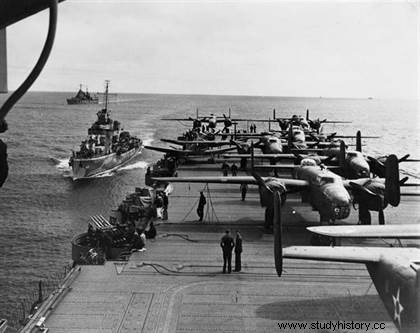 Nothing seems to be able to stop the Japanese advance in the Pacific during the six months following Pearl Harbor:they landed in Borneo on December 15, then it was the turn of the islands of Sumatra and Timor to fall in early 1942; Australia is now threatened, Java capitulates in March. The Japanese turn quickly, from the end of December 41, towards Burma which bothers them so much in their conflict against China. On March 8, Rangoon fell, causing a very painful British retreat, and in June 42 Japanese control was total.
Nothing seems to be able to stop the Japanese advance in the Pacific during the six months following Pearl Harbor:they landed in Borneo on December 15, then it was the turn of the islands of Sumatra and Timor to fall in early 1942; Australia is now threatened, Java capitulates in March. The Japanese turn quickly, from the end of December 41, towards Burma which bothers them so much in their conflict against China. On March 8, Rangoon fell, causing a very painful British retreat, and in June 42 Japanese control was total.
His incredible success prompted Japan to attempt to attack India, through Ceylon in April 1942; it was a failure, certainly not very important at the time, but which announced the first setbacks and some flaws in the Japanese armor and strategy... Thus, Tokyo was bombed for the first time on April 18, 1942 by Doolitttle planes.
From the Battle of Midway to Guadalcanal
The successes in the Pacific of late 41-early 42 were truly impressive, but this did not hide the first flaws in Japanese strategy, especially in the long term . Already, the management of these conquered territories poses problems and Japan responds most often with great violence, even if it initially enjoys a certain prestige among populations “liberated” from the Western colonial powers. We are already talking about Pearl Harbor as a "pyrrhic victory". Faced with the effort that awaits it – resisting the underestimated American counterattack – Japan will have to practice a shortage economy, which will weigh on its population.
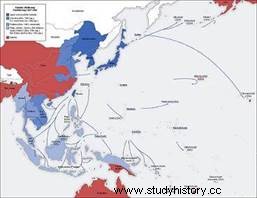 For their part, the Americans began to react in the Pacific from the beginning of 1942:their economy has become a war economy , with almost unlimited capacity. They sent troops to Australia in February, and reorganized their fleet. Regarding this one, we must note the great lack of the attack on Pearl Harbor, which will weigh for the future:if the Japanese sank a few battleships (the majority of which will be refloated), they did not hit any carriers. planes, none being present at that time in the harbour...Thus, it was from the Hornet that Doolittle's planes flew, and from March 42, the American aircraft carriers were able to carry out actions against the fleet Japanese.
For their part, the Americans began to react in the Pacific from the beginning of 1942:their economy has become a war economy , with almost unlimited capacity. They sent troops to Australia in February, and reorganized their fleet. Regarding this one, we must note the great lack of the attack on Pearl Harbor, which will weigh for the future:if the Japanese sank a few battleships (the majority of which will be refloated), they did not hit any carriers. planes, none being present at that time in the harbour...Thus, it was from the Hornet that Doolittle's planes flew, and from March 42, the American aircraft carriers were able to carry out actions against the fleet Japanese.
Japan must react to prevent the American awakening by removing its support in the South Pacific:the city of Port Moresby in New Guinea, moreover, possible stepping stone to Australia, becomes the main objective. However, during the Battle of the Coral Sea from May 4 to 8, 1942, the American fleet won despite the loss of the aircraft carrier Lexington, and the Japanese offensive was stopped. Admiral Yamamoto nevertheless still has the initiative and he decides to counterattack in the center of the Pacific Ocean, attacking Midway , a small poorly defended islet. The great Japanese strategist, at the origin of Pearl Harbor, hopes to trap and destroy the American fleet there; but in this gigantic game of hide and seek, it is the Americans who strike first:four Japanese aircraft carriers are destroyed, against one. The Japanese defeat is terrible in more ways than one:the balance of naval forces is restored, and they lose the majority of their best pilots.
The Americans took the initiative:they decided to take advantage of it in the following weeks by attacking the Japanese in the Solomon Islands, at Guadalcana l . The battle, both land and naval air, took place from August 1942 to February 1943. The Japanese had to withdraw:they were no longer invincible.
Between war of attrition and frog leaps…
 The year 1943 is a year of transition . The Japanese realized their mistake too late in having concentrated on the South Pacific in this way, and suffered increasingly worrying logistical problems. They resist all the same, thanks to their fortress of Rabaul. But, in the North, in the Aleutian Islands, they experience new defeats. Similarly, if they still hold Burma firmly, they cannot expand into the Indian Ocean and thus threaten supplies for China. This one continues its fight, helped by Anglo-American troops, like the famous Flying Tigers, and it manages by a negotiation between Tchang Kaï-Shek and the Allies to see its sovereignty recognized. Japan is still trying to exploit its sphere of co-prosperity:it consolidates its alliances with Thailand and Chinese dissidents, and ensures Russian neutrality.
The year 1943 is a year of transition . The Japanese realized their mistake too late in having concentrated on the South Pacific in this way, and suffered increasingly worrying logistical problems. They resist all the same, thanks to their fortress of Rabaul. But, in the North, in the Aleutian Islands, they experience new defeats. Similarly, if they still hold Burma firmly, they cannot expand into the Indian Ocean and thus threaten supplies for China. This one continues its fight, helped by Anglo-American troops, like the famous Flying Tigers, and it manages by a negotiation between Tchang Kaï-Shek and the Allies to see its sovereignty recognized. Japan is still trying to exploit its sphere of co-prosperity:it consolidates its alliances with Thailand and Chinese dissidents, and ensures Russian neutrality.
While each side has reorganized, the offensive resumes on the Allied side. Successes in Solomon allow Nimitz and MacArthur to launch their “frog leap” strategy:rather than conquering each islet at the cost of heavy losses, we decide to bypass the biggest points of resistance; this is the case of Rabaul for example.
In China , the differences between communists and nationalists jeopardize the Allied progress, essential since they make it possible to block more than a million Japanese fighters; in April 1944, a Japanese offensive decimated the Nationalist troops; Allied progress would not resume until October of the same year...Differences also arose between the British and Americans for the operations in Burma, culminating in the stormy relations between Stilwell (a sort of Patton in the Pacific theatre) and Wavell (responsible for the Rangoon debacle). The Japanese proved to be superior to the Allies in jungle combat, and it was not until May 1944 that the Allies, thanks to the Chinese, experienced their first success in Burma!
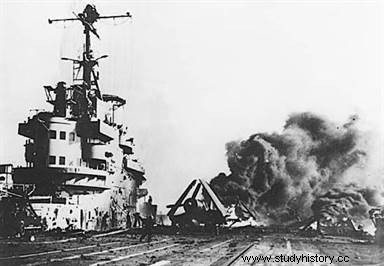 This relative status quo on the Asian continent brings the bulk of the conflict back to the South Pacific. The “frog leap” strategy began at the end of 43 with the offensive on the Gilbert Islands, with the terrible fighting on Tarawa; then it's the turn of the Carolinas, with one of the major Japanese bases:Truk. Japanese troops must withdraw to Singapore while the American army and navy fall on the Marshalls in May 1944:the following month, Saipan falls, bringing about the fall of Tojo in government! The Americans are entering the final phase, and the Philippines are reaching out to them.
This relative status quo on the Asian continent brings the bulk of the conflict back to the South Pacific. The “frog leap” strategy began at the end of 43 with the offensive on the Gilbert Islands, with the terrible fighting on Tarawa; then it's the turn of the Carolinas, with one of the major Japanese bases:Truk. Japanese troops must withdraw to Singapore while the American army and navy fall on the Marshalls in May 1944:the following month, Saipan falls, bringing about the fall of Tojo in government! The Americans are entering the final phase, and the Philippines are reaching out to them.
The atomic bombings and the end of the Pacific War
General MacArthur promised to return to Manila. US Marines, supported by an armada of 700 ships, land at Leyte in October 1944. The desperate reaction of the Japanese fleet provokes the greatest naval air battle of all time, but the forces are too disproportionate and the Imperial Navy is annihilated! It is at this moment that the kamikazes appear, the last resort of an army adrift to try to inflict heavy losses on its enemy... The Japanese relentlessness continues on earth, and the conquest of the Philippines is long and arduous :they only fall in May 1945! This had the first consequence of isolating the Japanese present in Burma and the Dutch East Indies, facilitating Allied operations in these regions.
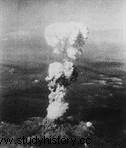 The populations of the countries "liberated" by the Japanese empire began to revolt, and the sphere of co-prosperity was reduced to a trickle:Indonesia obtained its independence, Burma was evacuated in the first months of 1945, Rangoon surrendered on May 2... Only Indochina posed problems for the Allies:the Japanese settled there firmly in January 1945, and the French troops of General Sabattier had to flee to China; Laos and Cambodia proclaim their independence with the support of Tokyo. In Cochinchina, this is the moment chosen by Ho Chi Minh to also declare the independence of the “Democratic Republic of Vietnam” on September 2, 1945! De Gaulle must send Leclerc to quell the rebellion...
The populations of the countries "liberated" by the Japanese empire began to revolt, and the sphere of co-prosperity was reduced to a trickle:Indonesia obtained its independence, Burma was evacuated in the first months of 1945, Rangoon surrendered on May 2... Only Indochina posed problems for the Allies:the Japanese settled there firmly in January 1945, and the French troops of General Sabattier had to flee to China; Laos and Cambodia proclaim their independence with the support of Tokyo. In Cochinchina, this is the moment chosen by Ho Chi Minh to also declare the independence of the “Democratic Republic of Vietnam” on September 2, 1945! De Gaulle must send Leclerc to quell the rebellion...
Americans initiate final act of crushing Japan . They have already taken advantage of their advance to launch massive bombardments on the main Japanese cities, causing considerable damage and appalling losses; thus, on March 9, 1945, the bombardment of Tokyo using incendiary munitions caused the death of 185,000 civilians... It was time to break down the last barriers leading to the heart of the Japanese empire:these were the two deadly battles from Iwo Jima (February-March 1945) and Okinawa (April 1945). American troops are at the gates of Japan, 500 km from Kyushu, and the blockade of the archipelago begins.
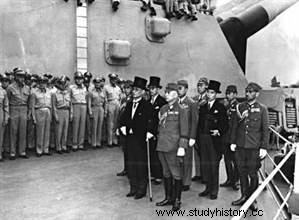 Yet quickly the possibility of bringing Japan down by starvation and even more so by landing, s 'distant. The Allies fear Japanese fanaticism , they know that several thousand suicide planes are waiting for them, and that the civilians are ready to sacrifice themselves, as they have done in the islands, in particular in Okinawa. Moreover, the USSR also threatens to invade Japan, and the rivalries of the future cold war are already very present... A radical means is needed to decapitate Japan for good:Truman then authorizes the use of the new weapon , the atomic bomb . On August 6, Hiroshima was struck. On August 8, the USSR attacked Japan. On the 9th, Nagasaki suffered nuclear fire... Emperor Hiro Hito announced the capitulation on the radio, and on August 15, Japan laid down its arms.
Yet quickly the possibility of bringing Japan down by starvation and even more so by landing, s 'distant. The Allies fear Japanese fanaticism , they know that several thousand suicide planes are waiting for them, and that the civilians are ready to sacrifice themselves, as they have done in the islands, in particular in Okinawa. Moreover, the USSR also threatens to invade Japan, and the rivalries of the future cold war are already very present... A radical means is needed to decapitate Japan for good:Truman then authorizes the use of the new weapon , the atomic bomb . On August 6, Hiroshima was struck. On August 8, the USSR attacked Japan. On the 9th, Nagasaki suffered nuclear fire... Emperor Hiro Hito announced the capitulation on the radio, and on August 15, Japan laid down its arms.
On September 2, 1945, on the Missouri anchored in Tokyo Bay, the unconditional surrender of Japan was signed. They lost 1,140,000 soldiers, 700,000 civilians; the Americans lost 90,000 men, the British 227,000, Australia 46,000. The world is entering a new era, that of the atom and the Cold War. As for the region, it is already preparing for other wars…
Non-exhaustive bibliography
- P. Souty, The Pacific War 1937-1945 , PUL, 1995.
- F. Boy, War of the Pacific , Casterman, 1997.
- J. Costello, War of the Pacific. Pygmalion, 2010.
